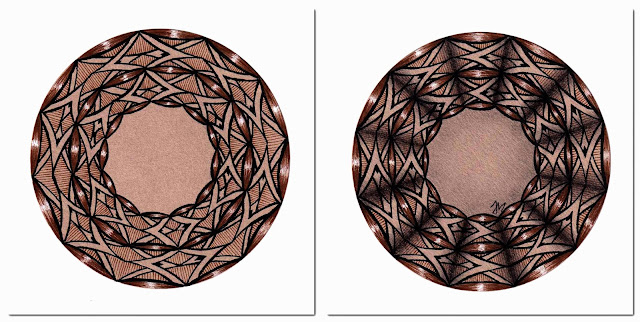It's been a very long time since I posted here, and just as long since I shared a new tangle. Despite appearances I haven't fallen away from Zentangle, I still love it as much as ever, although life doesn't allow me to spend quite as many hours with tile and pen these days. Any tangle time and energy I have I use to make art, rather than writing about making art.
Over the years I've gathered lots of scraps of paper with ideas for potential tangles. Some I revisit, play with and put aside as something isn't quite working. Sometimes I return to them and discover what was missing. Last year a tangle originally conceived at the end of 2018 fully came to life – and that tangle was Blap.
I submitted Blap to Conzentric's Step-Out of the Month and they shared it with the world last November. You can sign up to their monthly mailing here – you will receive an exclusive new tangle on the first of every month. You can also see the list of previously featured tangles here.
As I said in the text accompanying my step-out –
"Blap began as a simple ribbon tangle... recently I noticed how Blap's potential could be extended if I considered one section and used it almost like a fragment. From there it's easy to adapt it to a grid tangle, or a circular design.
Drawn entirely using C curves it clearly shares DNA with tangles like Zenith, Goldhan and Double Double and no doubt others.
My top tip is to always draw the inset curved V shape first, as it's far easier to fit the next parallel V inside than it is to draw it outside!"
Each month Conzentric invites tanglers to share their explorations of the monthly tangle in a dedicated Facebook group. It's always an honour and a thrill to see people using a tangle you created, and it inspired me to work further with Blap.
 |
| Blap can take on a new look if you make the V shapes U's instead. An orb to aim for might help. My blue bijou with 4 Blap fragments was duplicated in collage software. |
Recently I gave Blap a couple more outings, with some satisfying results. The first takes on a more ornate style - with detail lines, Beadlines, Mooka, and other bits and bobs.
 |
| Tangled in black on an ATC coloured with Eau de Nil ink by Diamine. |
The second shows another way to use Blap in a circular design, but with a less spiky appearance than the one featured on the step-out image. The difference on this tan pastel tile is down to the orientation of the Blap fragment.
 |
| Before and after shading - proving once again how much it adds to your work! There were different ways I could have shaded this, but I opted for block shading to create a puffy appearance. |
I like a tangle with plenty of potential for variation and I certainly think Blap has that. I'm looking forward to seeing what more it has in store for me – and I'd love to see what you do with it too.




































